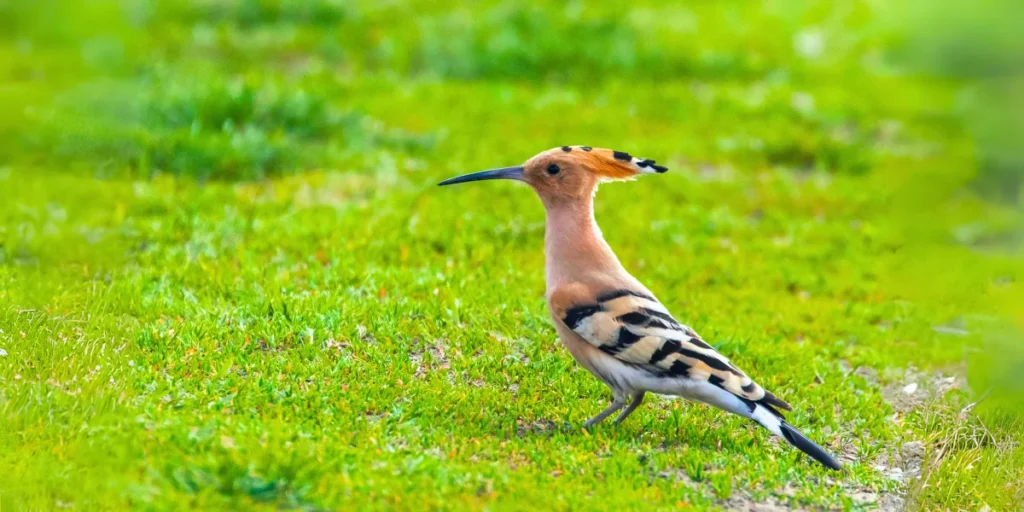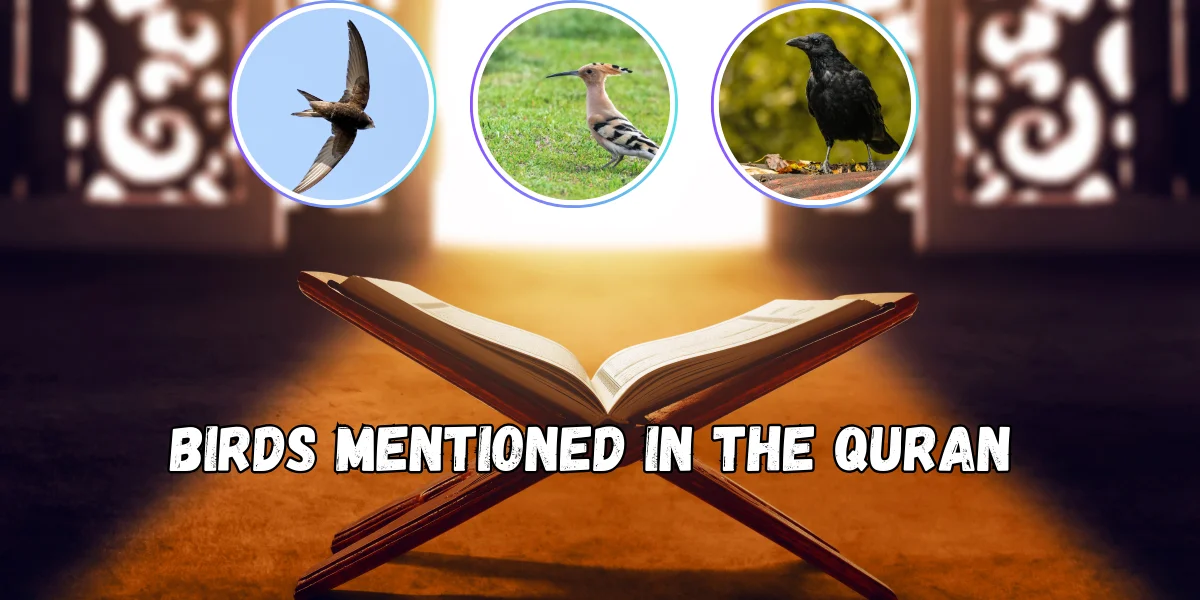List of Birds Mentioned in the Quran
| Bird | Surah (Chapter) | Ayah (Verse) | Significance |
|---|---|---|---|
| Hudhud (Hoopoe) | Surah An-Naml (The Ant) | 27:20-22 | Messenger for Prophet Solomon, symbolizing intelligence and loyalty. |
| Ababil (Flocks of Birds) | Surah Al-Fil (The Elephant) | 105:3-4 | Sent by God to protect the Kaaba, representing divine protection and intervention. |
| Al-Ghurab (Crow) | Surah Al-Ma’idah (The Table Spread) | 5:31 | Taught Cain how to bury his brother, symbolizing wisdom, repentance, and learning from nature. |
| Unnamed Birds | Surah Al-Baqarah (The Cow) | 2:260 | Used by Prophet Abraham to demonstrate resurrection, symbolizing God’s power over life and death. |
| Birds in General | Surah An-Nur (The Light) | 24:41 | Represented as creatures that praise and glorify God, symbolizing devotion and natural worship. |
The Quran, the holy book of Islam, is filled with divine guidance, stories, and wisdom that inspire believers to live a righteous life. Among its many lessons, there are references to birds that carry deep spiritual meanings and symbolize God’s power, wisdom, and protection. Birds are often used in the Quran to teach lessons, demonstrate God’s miracles, and show the beauty of His creation.
This article explores some of the birds mentioned in the Quran, their significance, and the lessons we can learn from them.
1. Hudhud (The Hoopoe)
One of the most famous birds mentioned in the Quran is the Hoopoe (Hudhud). This bird appears in Surah An-Naml (Chapter 27: The Ant) in the story of Prophet Solomon (Sulaiman). The hoopoe was an important messenger for Solomon and played a crucial role in spreading his message.

The Story:
Prophet Solomon was known for his wisdom and ability to communicate with animals. One day, he noticed that the hoopoe bird was missing. He expressed his concern and said he would punish the bird unless it had a good reason for being absent. When the hoopoe returned, it brought important news about the land of Sheba (Saba’). The hoopoe informed Solomon that the people there were worshiping the sun instead of God. Solomon then sent a message to the Queen of Sheba, inviting her to believe in one God.
Reference in the Quran:
“But the hoopoe stayed not long and said, ‘I have encompassed [in knowledge] that which you have not encompassed, and I have come to you from Sheba with certain news.'” (Quran 27:22)
Significance:
- The hoopoe symbolizes intelligence, loyalty, and observation.
- The story teaches the value of seeking truth and spreading guidance.
- It highlights how God can use even small creatures like birds to fulfill His divine plans.
2. Ababil (Flocks of Birds)
The Ababil birds are mentioned in Surah Al-Fil (Chapter 105: The Elephant), which describes a miraculous event that happened before the birth of Prophet Muhammad (peace be upon him). This incident is known as the “Year of the Elephant.”

The Story:
An army led by a ruler named Abraha marched towards Mecca with elephants, intending to destroy the Kaaba. However, God sent flocks of small birds called Ababil to protect His holy house. These birds carried small stones and dropped them on the army, causing great destruction.
Reference in the Quran:
“And He sent against them birds in flocks, striking them with stones of hard clay.” (Quran 105:3-4)
Significance:
- The Ababil birds represent divine protection and God’s power to defend His holy places.
- The story emphasizes that no force, no matter how powerful, can overcome God’s will.
- It teaches believers to trust in God’s protection, even in the face of overwhelming odds.
3. The Crow (Al-Ghurab)
The crow is another bird mentioned in the Quran in relation to the story of Cain and Abel (Qabil and Habil). This is one of the earliest stories in the Quran that highlights the consequences of jealousy and the value of repentance.

The Story:
After Cain killed his brother Abel out of jealousy, he didn’t know what to do with his brother’s body. God sent a crow to show Cain how to bury his brother by digging the ground with its beak.
Reference in the Quran:
“Then Allah sent a crow searching in the ground to show him how to hide the disgrace of his brother. He said, ‘Oh, woe to me! Have I failed to be like this crow and hide the body of my brother?’ And he became of the regretful.” (Quran 5:31)
Significance:
- The crow symbolizes wisdom and learning from nature.
- It served as a teacher to Cain, reminding us that even animals can carry important lessons.
- The story emphasizes the need for remorse and the importance of learning from mistakes.
4. Birds in the Story of Prophet Abraham (Ibrahim)
Another important mention of birds is found in Surah Al-Baqarah (Chapter 2: The Cow), where Prophet Abraham asks God for a sign to strengthen his faith in resurrection.
The Story:
Prophet Abraham wanted to understand how God gives life to the dead. God instructed him to take four birds, train them, and then cut them into pieces. He was told to place the pieces on different hills and call them. By God’s command, the birds came back to life and returned to Abraham.
Reference in the Quran:
“And [mention] when Abraham said, ‘My Lord, show me how You give life to the dead.’ [Allah] said, ‘Take four birds and commit them to yourself. Then put on each hill a portion of them; then call them – they will come [flying] to you in haste.'” (Quran 2:260)
Significance:
- This story teaches the power of God to resurrect the dead.
- It strengthens the belief in the Day of Judgment.
- It shows that God is willing to guide and strengthen the faith of those who seek the truth.
5. Birds Praising God
Birds are also mentioned in the Quran as creatures that naturally praise and glorify God. They are part of God’s creation that continuously remembers and worships Him, teaching humans to also be thankful and obedient to their Creator.
Reference in the Quran:
“Do you not see that Allah is exalted by whomever is within the heavens and the earth and by the birds with wings spread [in flight]? Each [of them] has known his means of prayer and exalting [Him], and Allah is Knowing of what they do.” (Quran 24:41)
Significance:
- Birds are symbols of devotion, freedom, and the natural order.
- Their continuous praise of God teaches humans to be mindful of their spiritual duties.
- This verse encourages believers to reflect on God’s creation and be inspired to worship Him.
Conclusion
The Quran’s references to birds are filled with wisdom and spiritual lessons that go beyond their physical existence. From the hoopoe’s intelligence, the protective flocks of Ababil, the crow’s guidance, to the resurrection lesson with Prophet Abraham, each bird plays a unique role in conveying God’s messages.
These stories remind believers to observe the world around them, learn from nature, and strengthen their faith in God’s power and wisdom. The presence of birds in the Quran is a powerful reminder of the beauty of God’s creation and the intricate balance of life.
By reflecting on these stories, we are reminded to trust in God’s protection, seek knowledge, and always remain humble and grateful for His countless blessings.
FAQs
1. How many birds are mentioned in the Quran?
Several birds are referenced, including the hoopoe, crow, and flocks of Ababil.
2. What is the significance of the hoopoe in the Quran?
The hoopoe was a messenger for Prophet Solomon, symbolizing wisdom and loyalty.
3. What do the Ababil birds represent?
They signify divine protection, as they defended the Kaaba from destruction.
4. Why was the crow mentioned in the Quran?
The crow taught Cain how to bury his brother, symbolizing learning and repentance.
5. Do birds praise God in Islam?
Yes, birds are depicted as creatures that continuously glorify God.

1 thought on “Birds Mentioned in the Quran: Stories, Lessons, and Wisdom”